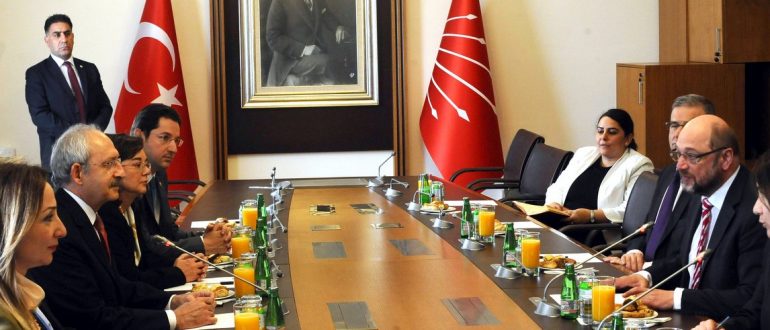Is the EU asylum policy caught in a “Joint-Decision Trap”?
Why does it seem so hard for the European Union to agree on a common asylum system? This essay looks for an answer in the institutional structure of the EU, based on Fritz Scharpf´s “Joint-Decision Trap”.
1. Introduction
The EU asylum policy has often been a very controversial topic. The latest conflict arose in 2011, when several thousand people from Tunisia and other North African countries arrived on the small Italian island of Lampedusa in boats.[1] For years, different governments and NGOs have demanded a reform of the EU asylum system (Bartels 2011). However, in 2008, a proposal by the Commission to change the Dublin II regulation was rejected by the EU Council. A new, modified, proposal from 2011 is subject to Council negotiations in 2012. But why does it seem to be so hard for the European Union to agree on a common asylum system? According to Fritz Scharpf, an answer to this question might be found in the “Joint-Decision Trap”, made from unanimous decisions and bargaining decision style.
To find out whether the European Union is caught in a joint-decision trap, I will first give an overview of the EU asylum policies from 1990 till today. Subsequently, I will summarize Scharpf´s theory of the joint-decision trap and form three hypotheses based on the theory. In the following analysis, I will compare the hypotheses to the reform process of the EU asylum system.
2. The development of the EU asylum policy
As a community of rich and democratic countries, the EU has been and continues to be attractive to migrants and refugees. When border controls within Europe were reduced because of the Schengen convention, the member states felt the need to regulate the responsibilities for asylum seekers. The cooperation of EU member states regarding asylum and migration policies started with the Dublin convention in 1990 (in power since 1997). The then 15 EU members agreed on some common rules for the reception of asylum seekers, including the ‘one-state-only’ principle[2]. In the following years, several treaties led to further cooperation and harmonization.
In 2004 a two-stage plan for a Common European Asylum System (CEAS) was developed with the The Hague Program. In June 2008 the Commission published a “policy plan on asylum” (COM(2008) 360) to complete the second phase of CEAS. In December a proposal was presented which, among other amendments to the Dublin regulation, included an exception to the obligation of a state to take back asylum seekers that have illegally entered another EU state (COM(2008) 820). To relieve overburdened states, the Commission suggested to suspend the transfer of asylum applicants when “a Member State is faced with a particularly urgent situation which places an exceptionally heavy burden on its reception capacities, asylum system or infrastructure, and when the transfer of applicants for international protection […] could add to that burden” (Article 31,1).
The Commission’s proposal was accepted in an amended version by the European Parliament; however, the Council could not come to an agreement. Therefore, the Commission worked on a new proposal, which came out in 2011 (COM(2011) 320) and is going through discussion in 2012.
3. “The Joint-Decision Trap” and EU asylum policy
In the article “The Joint-Decision Trap: lessons from German federalism and European integration” (1988) and its follow-up “The Joint-Decision Trap Revisited” (2006), Fritz W. Scharpf compares the way decisions are made within the European Union and in German federalism. He argues that in both cases “the fact that member governments are directly participating in central decisions, and that there is a de facto requirement of unanimous decisions, will systematically generate sub-optimal policy outcomes unless a ‘problem solving’ (as opposed to a ‘bargaining’) style of decision making can be maintained” (Scharpf 1988: 241).
Two central assumptions for this essay stem from Scharpf’s first article on the “Joint-Decision Trap”: The actors involved in the decision making process are expected to be intent on their own interests rather than benefits for the European Union as a whole. In this case, we can suppose that each country is interested in receiving as few asylum seekers as possible. As a consequence, those countries that receive a lot of asylum seekers will be interested in a reform of the Dublin II convention that would allow them to prevent transfers from other countries when they are ‘overburdened’ and vice versa.
In a press release on the third reading of the Commission´s proposal from 2008, it was mentioned that Malta, Greece and Cyprus were among the countries in favor of a reform (PRES(2010) 262). This reinforces the hypothesis that the countries act in their own interest: All three states receive a number of asylum seekers far above EU average (see Table 1).
Table 1: Pending asylum applications in the European Union by member state per million inhabitants (2008) [Source: own depiction with figures based on Eurostat data (8/2009, 30/2009, Press release 03/08/2009)].
By contrast, the press release continues, other member states, such as “Germany and Austria, maintained that the proper functioning of the Dublin II regulation was at the heart of any possible future Common European Asylum System” (ibid.). The relative number of refugees in Germany is below EU average (Table 1). However, the 2008 statistics show that Austria has to deal with more (relative) asylum applications than most EU states (Table 1). Still, the representatives speaking for Austria were in favor of keeping the Dublin II regulation up – thereby accepting that the country faces a high number of refugees relative to the small population. This fact contradicts Scharpf´s theory that the countries are just bargaining to get the best share.
Furthermore, if Scharpf’s theory holds, the decisions taken in the EU Council should be sub-optimal. For analytical reasons I will take the proposal by the Commission as the optimum.
Judging from the years 2008 to 2011, the results appear to be suboptimal. The Commission had to take back the 2008 proposal because “no position was reached on the text in the Council” (COM(2011) 320: 2). In the 2011 proposal Article 31 was completely excluded. Suspending the transfer of asylum seekers into an ‘overburdened’ country is therefore no longer possible. On the other hand, in 2010, the European Asylum Support Office (EASO) was established, which inter alia is supposed to support member states that are under particular pressure in implementing the asylum regulations (COM(2011) 320: 3).
In his 2006 article, Scharpf amends his theory by the role of the Commission. He notes that the Commission is able to develop solutions that rather promote a problem solving than a bargaining style. He states that the Commission could create win-win solutions “that go beyond the trivial exploitation of fixed policy preferences” (Scharpf 2006: 850). The third factor to be assessed is therefore in how far the Commission is able to provide a way out of the joint-decision trap.
It is yet to be decided whether the Commission succeeds with the new proposal as the negotiations in the Council are still going on. However, it is already clear that the Commission’s first try to reform Dublin II failed. This shows that, being confronted with the opinions of so many different stakeholders, it can be impossible to find a way for everyone to gain from a decision.
4. Conclusion
The analysis has shown that the picture that Fritz Scharpf draws of decision making in the European Union can account for a part of the process. More data would be necessary to get statistically significant information but the general direction of the hypotheses could be confirmed. A majority of countries appeared to be acting on their own interest and the result was suboptimal from the perspective of the Commission. The Commission’s potential to be an agenda-setter exists, yet it might be weaker than in the theoretical assumptions. In conclusion, it strongly depends on the frame of the analysis whether the EU seems to be in a joint-decision trap or not. The reaction of the Council to the 2008 proposal suggests that Scharpf is right but the result could be quite different if we looked at a longer time span or included more institutions, such as the European Parliament.
Still, knowing that the decision style in the EU Council can be a hindrance to EU integration could provide inspiration for future EU policies: To achieve more EU integration and thereby smoother policy reforms, an institutional reform could go in two different directions. The decision modes could be changed from consensus or qualified majority to simple majority. Another option would be to give more power to institutions that have ‘purely European’ representatives instead of domestic politicians who just take decisions for the EU as an addition.
by Anna Oechslen
Anna Oechslen studies social sciences in Berlin.
5. Bibliography
a) Secondary Sources
Albertinelli, Anthony; Juchno, Piotr (2009): Asylum applicants and decisions on asylum applications in Q1 2009. In: Eurostat – Data in focus (30). Web. 22 March 2012 <http://www.eds-destatis.de/de/downloads/sif/qa_09_008.pdf>
Albertinelli, Anthony; Juchno, Piotr (2009): Asylum applicants and decisions on asylum applications in Q4 2008. In: Eurostat – Data in focus (8). Web. 18 March 2012 <http://epp.eurostat.ec.europa.eu/cache/ITY_OFFPUB/KS-QA-10-003/EN/KS-QA-10-003-EN.PDF>
Bartels, Johanna (2011): “Europa setzt auf schauerliche Strategien”, 14.02.2011. Web. 22 March 2012 <http://www.tagesschau.de/ausland/interviewbierdel100.html>
Bohne, Martin (2011): Schöne Worte und wenig Taten, 15.02.2011. Web. 22 March 2012 <http://www.tagesschau.de/ausland/eufluechtlingspolitik100.html>
Bundesministerium des Innern (ed.): Asyl- und Flüchtlingspolitik. Web. 22 March 2012 <http://www.bmi.bund.de/DE/Themen/MigrationIntegration/Recht_EU/EU_Asylpolitik/asylpolitik_node.html>
Eurostat Press Office (08.03.2009): 5.4 million children born in EU27 in 2008. EU27 population reaches 500 million. Web 04 March 2012 <http://epp.eurostat.ec.europa.eu/cache/ITY_PUBLIC/3-03082009-AP/EN/3-03082009-AP-EN.PDF>
Focus Online (26.04.2011): Italien und Frankreich wollen Schengen-Abkommen ändern. Web. 04 March 2012 <http://www.focus.de/politik/weitere-meldungen/tunesien-italien-und-frankreich-wollen-schengen-abkommen-aendern_aid_621552.html>
Haase, Marianne; Jugl, Jan C. (2007): Asyl- und Flüchtlingspolitik der EU. Web. 22 March 2012 <http://www.bpb.de/themen/7H6FAJ,0,0,Asyl_und_Fl%FCchtlingspolitik_der_EU.html>
Lewis, Jeffrey (2003): Institutional Environments And Everyday EU Decision Making: Rationalist or Constructivist? In: Comparative Political Studies 36 (1/2), S. 97–124.
Lewis, Jeffrey (2005): The Janus Face of Brussels: Socialization and Everyday Decision Making in the European Union. In: International Organization 59 (4).
Pro Asyl (13.12.2011): Jahresbilanz der EU-Flüchtlingspolitik. Web. 04 March 2012 <http://www.proasyl.de/de/presse/detail/news/jahresbilanz_der_eu_fluechtlingspolitik/>
Resolution 429(V) (14.12.1950): United Nations Convention on the Status of Refugees. Web. 22 March 2012 <http://www.unhcr.org/refworld/docid/3b00f08a27.html>
Scharpf, Fritz W. (1988): The Joint-Decision Trap. Lessons from German federalism and European integration. In: Public Administration 66, S. 239–278.
Scharpf, Fritz W. (2006): The Joint-Decision Trap Revisited. In: Journal of Common Market Studies 44 (4), S. 845–864.
UNHCR (ed.) (2011): The 1951 Convention relating to the status of refugees and its 1967 protocol. Web 04 March 2012 <http://www.unhcr.org/4ec262df9.html>
b) Official EU documents
COM(2008) 360, 17 June 2008
Communication from the Commission to the European Parliament, the Council, the European Economic and social Committee and the Committee of Regions. Policy Plan on Asylum. An integrated approach to protection across the EU.
COM(2008) 820, 03 December 2008
Proposal for a regulation of the European Parliament and of the Council, establishing the criteria and mechanisms for determining the Member State responsible for examining an application for international protection lodged in one of the Member States by a third-country national or a stateless person
COM(2011) 320, 01 June 2011
Amended proposal for a directive of the European Parliament and of the Council, laying down standards for the reception of asylum seekers.
Council Regulation (EC) No 343/2003, 18 February 2003
Council Directive, establishing the criteria and mechanisms for determining the Member State responsible for examining an asylum application lodged in one of the Member States by a third-country national
PRES(2010) 262, 08 October 2010
Press Release, 3034th Council Meeting, Justice and Home Affairs
SEC(2008) 2962, 03 December 2008
Commission staff working document, accompanying the proposal for a Regulation of the European Parliament and of the Council, establishing the criteria and mechanisms for determining the Member State responsible for examining an application for international protection lodged in one of the Member States by a third-country national or a stateless person: Impact Assessment
[1] According to the Geneva Convention Relating to the Status of Refugees, a refugee is a person who, “owing to well-founded fear of being persecuted for reasons of race, religion, nationality, membership of a particular social group or political opinion, is outside the country of his nationality and is unable or, owing to such fear, is unwilling to avail himself of the protection of that country; or who, not having a nationality and being outside the country of his former habitual residence as a result of such events, is unable or, owing to such fear, is unwilling to return to it.” (Resolution 429(V): Article 1 A (2)). The definition of a refugee is by far more specific than that of a migrant, who can have many different reasons for moving to another country, including better economic or educational opportunities and other personal reasons (UNHCR 2011: 3). Strictly speaking, a great part of the people from North Africa who arrived on Lampedusa, were thus not refugees but migrants. Refugees are granted certain rights, for example “non-refoulement” (Resolution 429(V): Article 33), which means they may not be expelled to a country where they face a threat to their life and freedom. A person who is waiting to be granted refugee status is referred to as an asylum seeker.
[2]According to this rule, the state that allows an asylum seeker to enter the country will be responsible for him/her, and has to take him/her back if they illegally enter another EU state.



